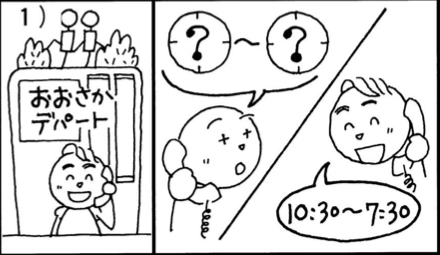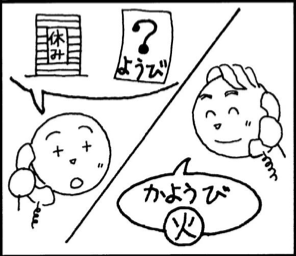Today we moved on to Kanji 2 and the second third of Lesson #6 as follows:
- Describing activities
- Using “after that” and “and then”
- Describing activities done at a place (place + object + verb)
- Using the word “like” in a sentence (I like movies)
- Vocabulary for places (will be added under the Vocab section)
Last lesson we looked at (object + verb) eating things. This lesson we describe more activities like watching a movie, reading a book etc.
DESCRIBING ACTIVITIES
Q:
What do you do on Sundays? | Nichiyobi ni nani wo shimasu ka? | にちようび に なに します か。
S:
Every Sunday I watch a movie. | Watashi wa maishu nichiyobi ni eiga wo mimasu. | わたし は にちようび に えいがを みます。
USING “AFTER THAT”
‘Kara’, roughly translated, means “after”. We learnt that a number of lessons ago when we touched on time. (‘Kara’ and ‘Made’) In Japanese, the phrase ‘Sore kara’ is literally translated from “after that” – ‘sore’ being “that” and ‘kara’ meaning “after”.
Q:
What do you do on Sundays? | Nichiyobi ni nani wo shimasu ka? | にちようび に なに を します か。
S:
In the morning I study. After that, in the afternoon, I watch a movie with my friend. | Asa benkyoshimasu. Sore kara, gogo tomodachi to eiga wo mimasu. | あさ べんきょうします。それ から、ごご ともだち と えいが を みます。
DESCRIBING ACTIVITIES DONE AT A PLACE
When describing something done at a particular place, the verb as usual goes at the end of the sentence, the object before the verb, and the place before the object. Structurally speaking, it goes: time/period + place + *particle de + object + *particle wo + verb. The particle ‘de |で’ is used because it is a location marker for action. (It is also used for describing how one takes the transport to somewhere)
S:
I ate toast at the canteen today. | Kyo shokudou de tosuto wo tabeshimashita. |きょう しょくどう で トースト を たべしました。
Q:
Where did you have breakfast today? |Kyo doko de asagohan wo tabeshimashita? | きょう どこ で あさごはん を たべました か。
S:
At home. | Uchi de tabeshimashita. | うち で たべました。
USING THE WORD “LIKE” IN A SENTENCE
Like | Suki | すき
To use “like” in a sentence, we need to add the *particle ga as a marker.
S:
I like movies.| Eiga ga suki desu. | えいが が すき です。
D:
Do you like movies? | Eiga ga suki desu ka? | えいが が すき です か。
– – – – – – Yes I do. | Hai, suki desu. | はい、すき です。
When and where do you watch movies? | Itsumo doko de eiga wo mimasu ka? |いつも どこ で えいが を みます か。
– – – – – – I often watch at Jurong Point GV. | Yoku Juron・Pointo no GV de mimasu. | よく ジュロン・ポイントの GV で みます。
I see. I also go to GV. | So desu ka. Watashi mo GV e ikimasu. | そう です か。わたし も GV へ いきます。
– – – – – – – – – – – – – – – – – – – – – –
**Difference between *particle e and *particle wo:
e | へ: direction marker – to show places that one goes to
wo | を: location marker – to show places one is at




 From this illustration, we can make two kinds of statements. One uses the particle ‘kara’ and ‘made’; this is a continuous statement. The other uses the particle ‘ni’; this is a momentary statement, used at the particular point in time.
From this illustration, we can make two kinds of statements. One uses the particle ‘kara’ and ‘made’; this is a continuous statement. The other uses the particle ‘ni’; this is a momentary statement, used at the particular point in time.